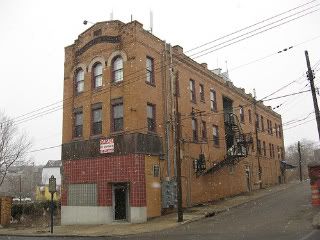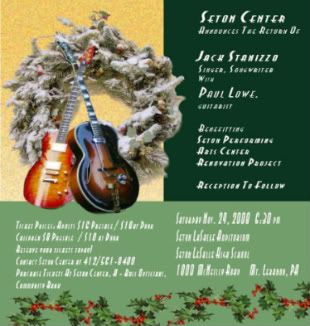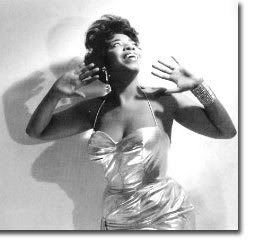
Photo Thanks to Katrencik at Flickr
Before the Civic Arena tore out its heart, the Hill District was one of the most vibrant African American neighborhoods in the country from the 1930s to the 1950s. Called "Little Harlem," the Hill drew bustling crowds both day and night. Its music scene rivaled any in America.
Pittsburgh was a jazz mecca then, and although it wasn't in Kansas City or New Orleans, Wylie Avenue often was the road that led musicians to New York and stardom.
In the Hill District, there were joints galore to keep things hopping: the Hurricane Lounge, Ritz, Showboat, Roosevelt Theater, Savoy Ballroom, Bamboola Club, Leondi Club, Green Front, Coobus Club, Little Paris, the Flamingo Hotel, Center Avenue Elks, Perry Bar, Granada Bar, Harlem Casino, Collins Inn, Bill Green's Casino and Terraced Gardens, Pythian Temple, Washington Club, and the Black Musicians Club, Local 471.
There were over 600 clubs in all, from one-man gin joints with a jukebox to opulent showcases with a band wailing on every floor. You couldn't take a step without hearing and breathing in the hot licks of jazz and soul wafting through the evening air.
The Hill's crown jewel was the Crawford Grill.
Six nights a week, the place was jumping and jiving. After it started the Friday and Saturday matinee performances, crowds were lined up outside the building both day and night.
Art Blakey, Mary Lou Williams, John Coltrane, Dakota Staton, Miles Davis, Charles Mingus, Dizzy Gillespie, Billy Eckstine, George Benson, Dr. Nelson E. Harrison, Richard "Groove" Holmes, Oscar Peterson, Nat King Cole, Thelonius Monk, Sarah Vaughn, Erroll Garner, Walt Harper, Louis Armstrong, Ella Fitzgerald, Stanley Turrentine, Chet Baker, and Max Roach where among those who performed on its 11'x11' stage that bisected a skinny building that was 120' long but only 20' wide.
The club was founded by North Carolina native William "Gus" Greenlee, a giant in Pittsburgh's African-American community.
Greenlee owned the Pittsburgh Crawfords, named after his night club, and dominated the city's African-American sports, entertainment, and gambling scenes. The source of his wealth, according to local lore, was hijacking beer trucks during prohibition and running a lucrative numbers operation.
He was simply the king of the Hill bookies. And in the African-American community, that made him a high-powered businessman and the local banker, too. Greenlee was both the man and an institution.
His original club, the first Crawford Grill (known as the Leader House before Greenlee took over), opened in 1931 at the corner of Wylie Avenue and Crawford Street in the Hill District, where Crawford Square sits today, across from the Civic Arena.
It was nearly a full city block in length. In the main room on the second floor, the audience surrounded a revolving stage and bought their drinks at a glass-topped bar. The third floor was where the real action took place. It was home to "Club Crawford", a sort of VIP Lounge for the glitterati of the era. It was papa of several Crawford grills to pop up in the City.
By 1943, Greenlee had a booming business and his numbers partner Joseph Robinson opened Crawford Grill No. 2 on Wylie Avenue, a companion spot to the original a few short blocks up the street.
After Greenlee's death in 1952, Robinson and his son Buzzy had the only Crawford in town. One story said the original succumbed to flames after Greenlee's death, while others say it fell to the wrecker's ball in 1956 during the Arena construction. (Our guess is the fire closed it and it was eventually demolished.)
Crawford Grill No. 3 opened in 1948 in Manchester, at the corner of Bidwell Street and Pennsylvania Avenue. It was shuttered in 1955, never generating the buzz of its Hill namesakes. "Crawford Grill on the Square" opened in 2003 in the Freight House Shops at Station Square. It fizzled, too, and closed in January, 2006.
But while it may not have been much of a franchise, The Grill on Wylie packed them in. Pittsburgh's steel economy helped local clubs boom.
In the 1940s and 1950s, the mills ran 24/7, and so did the city. Steel workers were shift workers with an irregular, rotating schedule, and their weekend consisted of whatever two days they happened to have off. As a result, the mill hands were looking for weekend entertainment every night of the week. The Crawford gave it to them. And everyone was welcome, black and white, the rich and the working man.
The Crawford Grill beacame a Pittsburgh landmark. Celebrities and politicians of all stripes would stop in, like Ethel Kennedy and Dr. Martin Luther King. In the evenings, the music drew an audience that included Roberto Clemente, Willie Stargell, the Rooneys, Kaufmanns, Frank Sinatra and Saichel Paige, all rubbing shoulders with the hoi polloi in the tightly packed structure.
White musicians who played downtown clubs would head uptown to The Grill after their gigs to jam into the night with black musicians. You could run across just about anyone at the Crawford, and you couldn't beat the music that never seemed to stop.
The Grill was immortalized by Hill District native August Wilson, who included it in his 1985 play "Fences," part of his Pittsburgh Cycle of works and a Pulitzer prize winner.
Now, the Hill wasn't a exactly a slice of heaven, even then. It was still segregated to a large degree, many of the homes were shacks, and a lot of the spots were for locals only. But at night, it was another world, as close to Broadway as Pittsburgh would ever get. The streets were filled with people, and nobody worried too much about their backs.
All good things come to an end, and in this case, the Crawford Grill suffered the common fate of its home, the Hill. The first blow was struck when the City demolished the Hill District in the late 50s, and the MLK riots of 1968 sealed the deal. The Hill looked like a war zone with shuttered buildings and vacant lots, and the clubs - and more importantly, the sense of community - were gone.
After the death of Joseph Robinson in 1982, the club was passed on to his son, William "Buzzy" Robinson, and the music reflected the times, with reggae, rap, and urban music being served. It wasn't enough, and The Crawford Grill closed in 2003.
The building sits forlorn now, empty with lots full of weeds alongside it. It's been for sale for years, with a price tag of $300,000 for it and a bundle of adjoining properties.
The Young Preservationists Association called the Crawford Grill one of its "Top Ten Best Preservation Opportunities in the Pittsburgh Area," in hopes of attracting a buyer who would develop the space with respect for its role in Pittsburgh's history.
But the rickety building would cost much more than that to a new owner. It needs gutted to get it back up to code, and with redevelopment popping up all around it, the fear is that some enterprising young entrepreneur will tear it down and put up...well, something that's not the Crawford. Funny how one Arena led to its eventual closing, and another may lead to its demolition.
Finding any buyer has so far been a challenge, Buzzy Robinson said. He's hoping for someone that respects the soul of the place, and at least keeps the facade intact. It's said that if you look closely, the stones outside the windows have the names of musicians that played the Grill etched into them.
Dr. Nelson E. Harrison called The Crawford Grill a "Spirit House," meaning that it was more than mere brick and mortar, but a depository of history and the souls of the men and women that filled its room.
We can only hope that someone with deep pockets, a love of jazz, and a sense of the past ends up with the deed. And it may have been; in April, 2010 a group of investors led by Franco Harris purchased the building, with plans to renovate it and return the club to its former glory.
(The history of the Crawford Grill is in Pittsburgh Magazine's "The Hill Was Alive With the Sound of Music" by Rick Sebak.)



